  The North American beaver, Castor canadensis has been considered a national symbol in Canada for over 300 years, and gained official status in 1975. The beaver fur trade was a large economic component of the colonization of Canada, and the species was hunted to near extinction as settlers shipped 100,000 pelts to Europe annually.
The North American beaver, Castor canadensis has been considered a national symbol in Canada for over 300 years, and gained official status in 1975. The beaver fur trade was a large economic component of the colonization of Canada, and the species was hunted to near extinction as settlers shipped 100,000 pelts to Europe annually. Nowadays, the beaver is no longer endangered, and is widespread across the United States, Canada, and even some parts of Mexico. Beavers live in forested areas where they can cut down trees for food and for building structures, including dams to expand their underwater habitat, and lodges to shelter in. 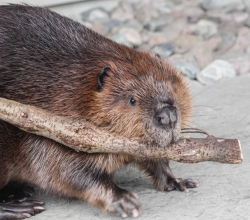 Beavers are North America's largest rodent, and worldwide, second in size only to the
capybara. Beavers are thickset and heavy, with dense brown underfur covered by coarse guard hairs. They are about 1.2 m long, including a 30 cm paddle-shaped tail, and can weigh as much as 32 kg. Their legs are short, with large webbed hind feet. They can use their forepaws like hands. Beavers are North America's largest rodent, and worldwide, second in size only to the
capybara. Beavers are thickset and heavy, with dense brown underfur covered by coarse guard hairs. They are about 1.2 m long, including a 30 cm paddle-shaped tail, and can weigh as much as 32 kg. Their legs are short, with large webbed hind feet. They can use their forepaws like hands. A pair of anal musk glands, or castors, produce castoreum, used by beavers to waterproof their fur; this continues to be used commercially in making perfume. Chisel-like front teeth enable the beaver to gnaw down trees that it uses for building dams, lodges, and canals.  Beavers are herbivores that eat tree bark and cambium, the tissue growing just under the bark. They travel long distances to find food, and build canals to it so they can float the trees back to their lodges. Logs and twigs are stored underwater for winter feeding. Their favorite trees include willow, maple, poplar, beech, birch, alder, and aspen. They also eat water vegetation, buds and roots. Since cellulose, which usually cannot be digested by mammals, is a major component of a beaver's diet, they have microorganisms in their cecum (a sac between the large and small intestine) to digest it. Beavers are herbivores that eat tree bark and cambium, the tissue growing just under the bark. They travel long distances to find food, and build canals to it so they can float the trees back to their lodges. Logs and twigs are stored underwater for winter feeding. Their favorite trees include willow, maple, poplar, beech, birch, alder, and aspen. They also eat water vegetation, buds and roots. Since cellulose, which usually cannot be digested by mammals, is a major component of a beaver's diet, they have microorganisms in their cecum (a sac between the large and small intestine) to digest it.
 One of the most remarkable things about beavers is their ability to modify their environment by building dams on creeks and small waterways that form ponds. These ponds create a large storage area for the beaver's food sources, and a place to build their lodges. One of the most remarkable things about beavers is their ability to modify their environment by building dams on creeks and small waterways that form ponds. These ponds create a large storage area for the beaver's food sources, and a place to build their lodges. The ponds create a habitat for other species including fish, mammals, waterfowl, songbirds, amphibians, and insects. After they're gone they increase the fertility of the soil and the diversity of living things. Beaver dams and ponds reduce soil erosion and retain sediment, absorbing and filtering pollutants like heavy metals, pesticides, and fertilizers. This improves the quality of water downstream used by humans and other species.  Beavers form monogamous pairs and usually live in family groups of up to 8 related individuals called colonies. They mate in January-February; female beavers are sexually mature at 2.5 years old. They give birth to one litter of kits per year, usually between April and July. The gestation period is about 3 months. Beavers form monogamous pairs and usually live in family groups of up to 8 related individuals called colonies. They mate in January-February; female beavers are sexually mature at 2.5 years old. They give birth to one litter of kits per year, usually between April and July. The gestation period is about 3 months.The kits are born with all of their fur, their eyes open, and their incisor teeth out. The younger siblings stay with their parents for up to 2 years, helping with infant care, food collection, and dam building. In the wild, beavers can live up to 12 years. The lodge can have several underwater entrances to keep out predators, with a large dry room inside that is used as a nursery and safe living area. It is well insulated by its thick walls and the surrounding water; the temperature is considerably warmer inside the lodges than outside. 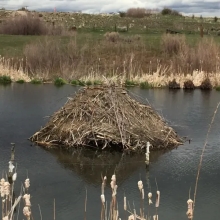
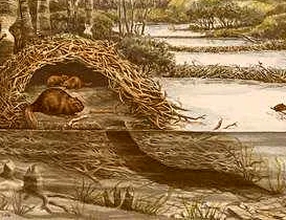 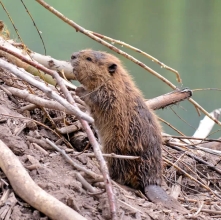 Beaver families are territorial and will defend against other families encroaching on their territory, and predators. In order to warn members of danger, beavers will slap their tails against the water, creating a powerful noise. The tails are one of the defining characteristics of beavers; they are broad and flat with large, blackish scales. Beavers also use their tails like tripods to stand up when cutting down a tree. By regulating blood flow through their tails, beavers can heat or cool themselves. 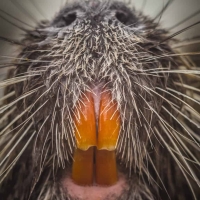 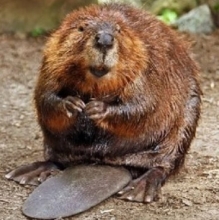 Beavers can hold their breath for up to 15 minutes. Like all rodents, beavers have large central incisors (front teeth) that are always growing. They must keep them trimmed by gnawing bark. Beavers are primarily crepuscular ... they are only occasionally seen during the day, usually being active only at dusk and dawn. The beaver's predators include wolves, wolverines,
cougars, lynx, and bears. Beavers can hold their breath for up to 15 minutes. Like all rodents, beavers have large central incisors (front teeth) that are always growing. They must keep them trimmed by gnawing bark. Beavers are primarily crepuscular ... they are only occasionally seen during the day, usually being active only at dusk and dawn. The beaver's predators include wolves, wolverines,
cougars, lynx, and bears.
Beavers are often seen as pests by farmers due to their dam-building activity, which sometimes has deleterious effects on irrigation patterns and farmland. However, their is no denying the beneficial outcomes from beaver dams and ponds, which can help lessen the effects of drought by increasing stream flow during drought periods and making ecosystems less vulnerable during dry periods. Ironically, beavers can also help minimize flood risks by holding a lot of water and slowly releasing it, delaying and reducing flood peaks further downstream. |